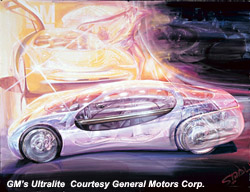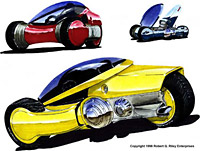"In truth, the ideas and images in men's minds are the
invisible
powers the constantly govern them."
John Locke
The world is facing a growing crisis with transportation energy use. Developing regions are rapidly emerging into consumer societies and these new consumers want the freedom of cars, which puts increased urgency on the need to reduce the energy intensity of personal mobility. "Energy intensity" simply refers to the amount of energy it takes to transport one person over one unit of distance. A passenger/mile or a passenger/kilometer is the common way of expressing it. It is natural to turn to technology for solutions. We need more efficient power systems and better batteries for electric cars. But better technology is only part of the solution, and it's the most costly and technically challenging part of it. The "design" of vehicles - vehicle styling, theme, and market positioning - are also powerful tools for reducing energy-intensity - in many ways, equally as important as the technology. This document focuses on the power of design to affect consumer choices and thereby fuel economy.
In reality, most of a car's energy is used to transport itself. In city driving, over 80 percent of a vehicle's energy goes to the effects of mass. The other 18 - 20 percent goes to overcoming air resistance, and air resistance is directly proportional to size (frontal area). Significantly smaller, lighter, and less energy-intensive vehicles could help turn the tide against mounting energy consumption and open new markets in the process - and do it with existing technology. But it can only be done with visionary new designs and vehicle themes. Cheap little cars are essentially without customers in high end markets. And consumers in emerging new markets will ultimately respond to the same attributes. So-called alternative cars must be desirable on their own merits. They cannot be marketed solely on their ability to reduce energy consumption, clean up CO2 emissions, and thereby save the planet. The motivation must come from their ability to capture the imagination of consumers using the power of their design.
The Power of Design
 The power of design to affect consumer perceptions is visible throughout the range of product categories, from kitchen appliances to fitness equipment to cars. A product's design speaks to us in a non-verbal language that conveys how the product will be experienced. Today's products provide more than just utility. They are experiences in living and working. And the experience is spoken in the art of their design. Whenever we purchase a product, we are also purchasing an experience - a mood, an ambiance, a lifestyle. We are purchasing a symbol of how we see ourselves and how we would like others to see us. The power of design to affect consumer perceptions is visible throughout the range of product categories, from kitchen appliances to fitness equipment to cars. A product's design speaks to us in a non-verbal language that conveys how the product will be experienced. Today's products provide more than just utility. They are experiences in living and working. And the experience is spoken in the art of their design. Whenever we purchase a product, we are also purchasing an experience - a mood, an ambiance, a lifestyle. We are purchasing a symbol of how we see ourselves and how we would like others to see us.
In his book, The Meanings of Modern Design, Peter Dormer discusses the camera as an object that transcends its mere function. Dormer describes the camera as having a precision craftsmanship of a quality that can come only from the automated processes of modern production methods - a technology of creating products that goes far beyond the flawed labors of human hands to create a pristine beauty that is uniquely its own. The feel of the camera in the hands, the tones of control inputs, the immaculately detailed case, and the crystalline purity of the lens are all imbued with the same flawless precision and add to the pleasure of owning and handling the product. The technical capabilities of the tools of photography far exceed utility to become an end in itself. The tools of photography embody a theme that gives the purchaser a pleasurable feeling whenever he or she partakes in it. Nowhere is this more important or more dramatically apparent than in automobile design.
Moving Past Focus Groups and Consumer Surveys
Market studies invariably produce a thumbs-down response to the idea of a small, lightweight car designed to save fuel. But studies based on abstract product ideas and biased by negative hypothetical attributes cannot show the market potential of real products that have yet to be developed. Consumers can hardly be expected to envision the appeal of an unfamiliar product idea before it has been rendered in the real world.
If, before the advent of inline skates, a market study were done to determine what consumers wanted in their roller skates, the study would have undoubtedly shown that they wanted more durable and quieter wheels, better bearings, and a more comfortable fit. But the study would not have shown that consumers wanted skates with a single row of wheels down the center. If the idea of inline skates had been proposed in a product clinic, participants would have surely rejected it. One could have certainly argued against the wisdom of introducing a totally new type of skate, requiring a new set of skills, to a universe of consumers who wanted only a better version of an existing and familiar product. Only through a sense of vision can product planners leapfrog over this impasse of logic.
 To conceive and execute visionary new product ideas requires breakthrough efforts of even the most talented product planners and designers. If a group of designers who had never seen a motorcycle were asked to create a design for a two-wheeled bodiless car, it is doubtful that a product like today's motorcycle would emerge. Even the best designers are compelled to work under the handicap of their own preconceived ideas and design paradigms. To paraphrase the quote by John Locke at the beginning of this discussion, "the ideas and images in the minds of designers invisibly guide them toward particular design options". A product's character naturally emerges from the mindset of its designers. Consumer appeal of any alternative vehicle design depends on the ideas and images in the minds of its creators, not on the core idea of saving energy and emissions through size/mass reduction. To conceive and execute visionary new product ideas requires breakthrough efforts of even the most talented product planners and designers. If a group of designers who had never seen a motorcycle were asked to create a design for a two-wheeled bodiless car, it is doubtful that a product like today's motorcycle would emerge. Even the best designers are compelled to work under the handicap of their own preconceived ideas and design paradigms. To paraphrase the quote by John Locke at the beginning of this discussion, "the ideas and images in the minds of designers invisibly guide them toward particular design options". A product's character naturally emerges from the mindset of its designers. Consumer appeal of any alternative vehicle design depends on the ideas and images in the minds of its creators, not on the core idea of saving energy and emissions through size/mass reduction.
Seeing Through New Eyes
Getting past one's mindset is one of the most difficult tasks for the designer attempting to create breakthrough new designs having the ability to change consumer perceptions and revolutionize markets. There is a humorous story in Joel Barker's book, Future Edge, about two market researchers who were sent, independently, to one of the world's less developed countries by one of the world's largest manufacturers of shoes. Their instructions were to report back on the potential market for shoes. When the first researcher arrived and observed the conditions, he immediately sent the following message to headquarters: "No market here. Nobody wears shoes." Within a few hours, headquarters received word from the second researcher, which read: "Great market here. Nobody has any shoes." By changing focus - by seeing through different eyes - interpretations can be turned upside down and inside out..
If new types of personal mobility vehicles are to become successful in the marketplace, it's important that these vehicles are designed to motive purchases on their own merits - capture the imagination of consumers. Their environmental benefits will become the primary "justification" while the real motivator will be the endorphin rush experienced by the prospective purchaser. Again, it helps to see it from the perspective of a different category of products, personal watercraft (PWC), for example.
Personal watercraft are not positioned as mini-boats, although they are indeed miniature boats. Through design, positioning, and advertising appeals, these small boats define a totally different product and a totally new market. When Kawasaki ads implored readers to "let the good times roll", they were describing how the product would be experienced. They were selling the image, the lifestyle, and the experience, and only indirectly selling the product.
Consider PWCs from the reverse perspective. Imagine for a moment that PWCs were positioned as environmentally friendly mini-boats costing somewhat less than full-size boats. And in our ads, we'll replace "let the good times roll" with a sales pitch on cleaning up the waterways by using our enviromentally friendly mini-boats and leaving big boats at home. Through the power of design and positioning, our environmentally friendly mini-boats have become essentially unmarketable products, even if they were to perform just like today's PWCs.
. When product planners and designers "let the good times roll" with alternative vehicle designs, the good times are likely to roll in the marketplace too.
XR3 Hybrid Video
|